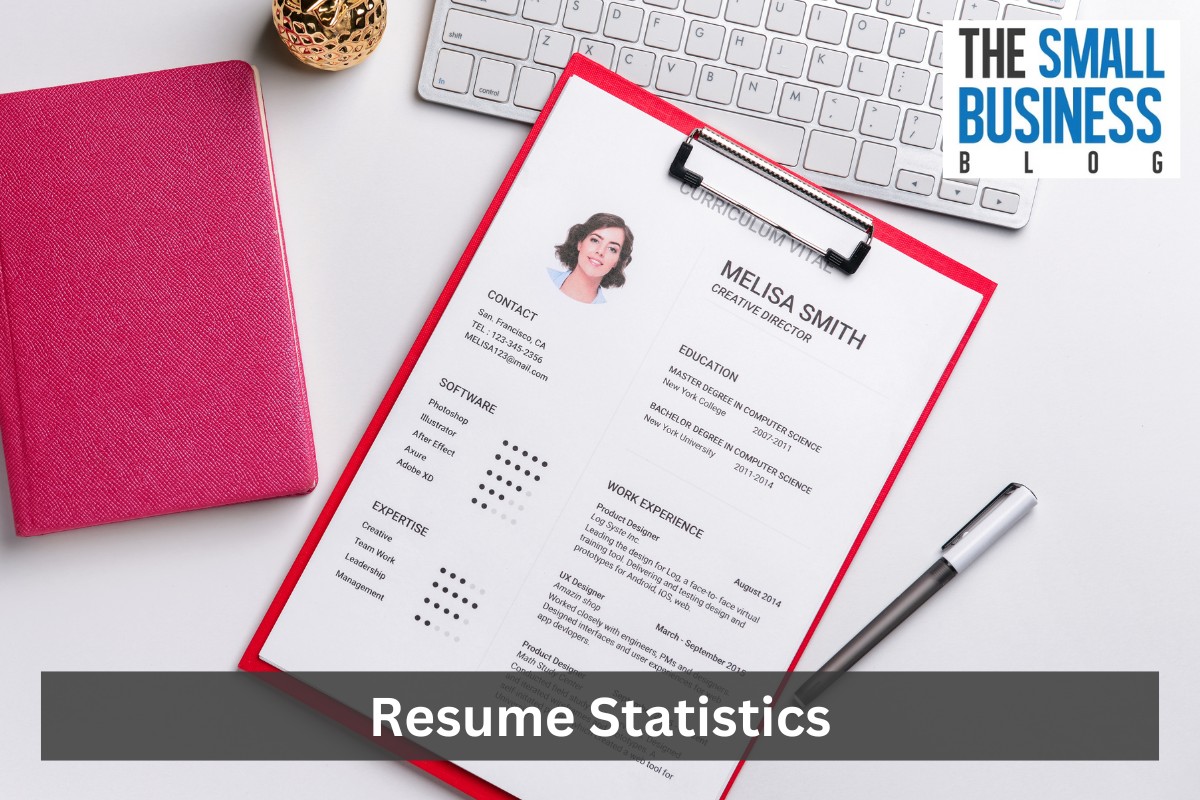How does your current resume look?
Could you get an interview with the one you have now, or does it need to be updated?
Either way, we are sharing some resume statistics you’re going to need if you plan to make effective changes to your resume.
Today, we live in a society where LinkedIn, online applications, and artificial intelligence tools are readily available.
There just seems like there’s no reason not to have a virtually perfect resume no matter what industry you work in or want to work in these days.
This article is for anyone seeking a job or for employers seeking top talent.
These statistics about resumes will discuss several aspects of resume formatting, recruiting tactics, and how these things affect hiring decisions.
Post Contents
- 1 Key Statistics
- 2 Top Resume Statistics in 2024
- 2.1 1. One opening at a corporate job receives an average of about 250 applications.
- 2.2 2. An estimated 80% of resumes never get past the initial cut.
- 2.3 3. Employers seldom spend more than 11 seconds on a resume before accepting or rejecting it.
- 2.4 4. 45% of job seekers use their mobile devices for job hunting.
- 2.5 5. A whopping 75% of resumes are never seen by human eyes.
- 2.6 6. 3 out of every 10 resumes are rejected by employers because of an unprofessional email address.
- 2.7 7. You need to submit between 50 and 100 resumes before landing a job.
- 2.8 8. 51% of resumes have cliches, poor grammar, and fluffy keywords/buzzwords.
- 2.9 9. More than 55% of American employees admit to lying on their resume.
- 2.10 10. 43% of the time, resumes that are outside the ideal word count are less hirable.
- 2.11 11. 60.6% of job seekers do use one-page resumes.
- 2.12 12. Recruiters in the U.K say that two pages is the ideal length for a CV.
- 2.13 13. 41% of hiring managers commonly review the skills section of a resume first.
- 2.14 14. 63% of recruiters say that the talent shortage is the biggest obstacle for finding top talent.
- 2.15 15. 91% of recruiters favor soft skills over hard skills on resumes.
- 2.16 16. 85% of recruiters think that job candidates exaggerate their skills.
- 2.17 17. Job descriptions include an average of 21.8 skills.
- 2.18 18. 61% of hiring managers surveyed say that customized resumes improve your chances of getting an interview.
- 2.19 19. 48% of resumes include a LinkedIn profile link.
- 2.20 20. Communications skills are at the top of the list for soft skills among employers.
- 3 FAQs
- 3.1 What is the best length for a resume?
- 3.2 What should be included in a resume?
- 3.3 Is a functional or chronological resume format better?
- 3.4 How should employment gaps be addressed on a resume?
- 3.5 What should you do with a resume when you have no experience?
- 3.6 What are resume keywords and should you use them?
- 4 Conclusion
Key Statistics
- One opening at a corporate job receives an average of about 250 applications.
- An estimated 80% of resumes never get past the initial cut.
- Employers seldom spend more than 11 seconds on a resume before accepting or rejecting it.
- 45% of job seekers use their mobile devices for job hunting.
- A whopping 75% of resumes are never seen by human eyes.
- 3 out of every 10 resumes are rejected by employers because of an unprofessional email address.
- You need to submit between 50 and 100 resumes before landing a job.
- 51% of resumes have cliches, poor grammar, and fluffy keywords/buzzwords.
- More than 55% of job seekers admit to lying on their resume.
- 43% of the time, resumes that are outside the ideal word count are less hirable.
Top Resume Statistics in 2024

1. One opening at a corporate job receives an average of about 250 applications.
According to Glassdoor’s 2015 eBook, 50 HR and Recruiting Stats That Make You Think, a single corporate job posting or opening will generate 250 resumes.
Of all these resumes, only between four and six will be called to interview and only one will get a job offer.
(Glassdoor for Employers)
2. An estimated 80% of resumes never get past the initial cut.
Statistics show that an estimated 80% of all resumes never make the first cut when hiring managers or employers are going through applications and resumes.
Many resumes get shortlisted by employers at two out of every ten they review.
(Workopolis)
3. Employers seldom spend more than 11 seconds on a resume before accepting or rejecting it.
60% of employers spend only an average of 11 seconds or less on resumes before they save or download them.
If they aren’t immediately interested, your resume will never even be saved or downloaded.
Therefore, your job application needs to make a quick and good impression.
(Workopolis)
4. 45% of job seekers use their mobile devices for job hunting.
Glassdoor revealed that a whopping 45% of job seekers are using their mobile devices to look for a job every day.
For employers that means your job listings should be reaching this audience if you’re not already.
It’s time to learn how to connect with mobile users and see them as top talent.
(Glassdoor for Employers)
5. A whopping 75% of resumes are never seen by human eyes.
Due to technology like AI (artificial intelligence) and ATS software, 75% of resumes never get seen by employers or hiring managers.
New technology makes resume reviewing faster and easier today since it’s designed to reject according to programming any resumes that don’t match the needs or wants of a job listing.
(CareerMinds)
6. 3 out of every 10 resumes are rejected by employers because of an unprofessional email address.

Did you know that 3 in 10 resumes are ignored due to an unprofessional email address?
If you’re using a silly email address, or your personal email address using a funny name or your nickname, your resume is likely to be ignored.
Use your real name, or initials to create a professional email address to boost your chances of being seen by recruiters, HR managers, employers, and hiring managers.
(StandOut CV)
7. You need to submit between 50 and 100 resumes before landing a job.
According to research, you will need to submit at least 50 and up to 100 resumes before you get hired.
Indeed’s blog recommends that you commit to sending 10 to 15 resumes per week, which means at least 2 to 3 per weekday.
In fact, commit to altering each resume to match the keywords in the job description as needed to further your chances of landing your job.
(Indeed, Zippia)
8. 51% of resumes have cliches, poor grammar, and fluffy keywords/buzzwords.
According to professionals, one of the best ways to get your resume tossed aside is to use poor grammar, buzzwords, fluff, or cliches in your resume.
Remember, a good rule of thumb is to be clear, concise, honest, and use good grammar and relevant keywords in your resume.
(Cultivated Culture)
9. More than 55% of American employees admit to lying on their resume.
One survey revealed that 55% of Americans have admitted to lying on their resume at least once in their lifetime.
The study surveyed 1,785 employed Americans aged 18 and up.
For the record, we don’t recommend lying on your resume for any reason.
Being honest is one of the key elements in resume writing.
(CNBC)
10. 43% of the time, resumes that are outside the ideal word count are less hirable.
How important is it to stay within the 475–600-word limit for your resume?
Research has found that 43% of the time, resumes that do go over the “ideal” word count are considered less hirable.
In terms of things that matter, this does.
(Forbes)
11. 60.6% of job seekers do use one-page resumes.
A Novoresume survey revealed that 60.6% of job seekers do have one-page resumes.
Moreover, 29.7% of job seekers have a two-page resume.
Both one-page and two-page resumes have a 2.9 times better chance of getting hired. Only 10% of job seekers have a 3-page or longer resume.
(MarketSplash, Novoresume)
12. Recruiters in the U.K say that two pages is the ideal length for a CV.
A CV (Curriculum Vitae) is the essentially the same thing as an American resume that includes your skills, work history, and education for applying to jobs.
In the U.K., 91% of recruiters surveyed said that two-page CVs are the ideal length.
(Reed, Novoresume)
13. 41% of hiring managers commonly review the skills section of a resume first.

This means that 41% of the time, the skills section of your resumes gets attention from hiring managers.
This tells us that employers, hiring managers, and whomever is doing the hiring at a company are looking for specific skills.
It makes sense that they look at that section of resumes first.
(MarketSplash, Novoresume)
14. 63% of recruiters say that the talent shortage is the biggest obstacle for finding top talent.
According to 63% of recruiters the biggest challenge that faces their ability to hire top talent is the talent shortage.
Yes.
The talent shortage is real, which is creating problems for companies finding top candidates for positions.
In simple terms, there simply aren’t enough qualified candidates to fill jobs today.
(Zippia)
15. 91% of recruiters favor soft skills over hard skills on resumes.
Soft skills involve emotional intelligence and is often referred to as people skills.
The idea of soft skills is the candidate’s ability to engage with others in a friendly, amiable, yet professional manner.
They should be able to handle conflict resolution, resolve problems, use empathy, be able to build customer relationships, and be able to work well with others in general.
(Finances Online, Novoresume)
16. 85% of recruiters think that job candidates exaggerate their skills.
Monster’s State of the Recruiter survey from 2019 revealed that 85% of recruiters claimed that candidates exaggerate their skills on their resumes.
Likewise, they also believe that candidates exaggerate their proficiencies.
Only one-third of surveyed recruiters believe job candidates are honest on their resumes.
(HRDive)
17. Job descriptions include an average of 21.8 skills.
Have you ever thought that job descriptions are egregious with how many skills they list for one job?
If so, you may be at least partly right.
Analyses of job descriptions show that each job listing has an average of 21.6 skills for the job mentioned on it.
In contrast, only and average of 13 skills are included on candidate resumes.
(Finances Online)
18. 61% of hiring managers surveyed say that customized resumes improve your chances of getting an interview.
According to research, 61% of hiring managers surveyed claim that customized resumes help boost your chances of getting a job.
Furthermore, only 11% of job applicants are categorized as suited for the jobs they apply for.
This tells us that customization is another important aspect of a solid and effective resume.
(Cardinal Staffing Services)
19. 48% of resumes include a LinkedIn profile link.
Statistics show that including your LinkedIn profile on your resume increases your chances of at least getting a job interview.
However, only 48% of resumes include a LinkedIn profile link.
If you’re a job seeker, think about that data next time you’re updating your resume.
(Cultivated Culture)
20. Communications skills are at the top of the list for soft skills among employers.

We mentioned the importance of soft skills earlier in the article, but which one is at the top of most employers’ list.
Communication skills are number one for employers.
In most jobs you will be working with others, talking to or chatting with customers, and sometimes talking to businesspeople.
You need to be able to speak politely and clearly in person, but also via phone and in written communications like email, chats, and texts.
Other soft skills include being a good listener, engaging in critical thinking, and being a decision maker.
(The Balance)
FAQs
What is the best length for a resume?
One or two pages is ideally the best resume length.
However, there are exceptions in terms of your experience level, the job you’re applying for, etc.
If your experience is high, you may be fine to have a three-page resume.
Cultivated Culture says that your resume should be no more than 475 to 600 words long.
Whatever you do, make sure your resume is clear, concise, and easy to read.
What should be included in a resume?
Every resume should include your name, contact information, skills, work experience, education, relevant honors and rewards, and accomplishments.
A summary statement or resume objective section to highlight your experience and skills is optional, but a clever idea.
Is a functional or chronological resume format better?
Chronological and functional resumes are both acceptable, so it depends on your level of experience and your skills.
Chronological resumes list your work experience starting with your current job backwards to your previous jobs.
A functional resume is designed to focus on your abilities and skills as opposed to your work experience or history.
How should employment gaps be addressed on a resume?
Be honest about your employment gaps on your resume.
Explain the circumstances of these gaps, like caretaking for a family member, etc.
This space on your resume can also be used to highlight any skills and abilities you gained during the gap.
What should you do with a resume when you have no experience?
If you’ve recently graduated from high school or college, or you are in the middle of a career change, you may lack some relevant work experience.
In this case, you should focus on your skills, education, volunteer work, or any extracurricular activities.
What are resume keywords and should you use them?
Resume keywords are phrases and words you obtain from the job description.
When you use these keywords on a resume, you’re more apt to be found among other candidates.
Research career and job keywords online, get them from specific job descriptions, or use a resume keyword tool.
Conclusion
Now we know that soft skills are important, but so is having a resume that is the right length, customized, and clear and concise.
You don’t want to be that job seeker making the most common mistakes in a world where the competition is fierce, and the top talent is lacking.
Employers should also take heed to know more about what their new talent demographic is and how to ensure you are striving to attract top talent.
We hope you have gotten value from this article and the resume statistics therein whether you’re a job seeker or employer.






























